paddlesteamers.info : The Internet's leading website for
Side-Wheeled Paddle Steamers
Royal and Imperial Yachts
Monarchs
and Emperors found good use for steamships for their own private use,
for visiting far-flung dominions and for diplomatic functions. The
British monarch Victoria, later to become Empress of India at the
Zenith of the new British Empire became possibly the world's most
powerful ruler at a time of industrial expansion and technical change.
Britain was at the forefront of these development and with dominions
stretching across the globe had the world's leading shipbuilding
industry to support her international trade, security and military
ambitions. It was therefore natural that Queen Victoria and her consort
Prince Albert who had a major interest in technical matters would look
to have the finest of vessels available for their use.
Although
sailing ships were available for the monarch to use, the new paddle
steamer Victoria & Albert, which became available for service in
1843 was a sea-change in quality. A number of new paddle steamers
designed specifically for royal use followed and other monarchs had
their own steamers built for their own purposes. Royal yachts remain in
service with many monarchs and in other countries, vessels remain
available for use by state presidents both for state and personal
purposes. Whilst paddle steamers gave way to screw steamers and
motor ships, one remarkable vessel, Egypt's El-Mahrousa survives.
Originally a London-built paddle steamer launched in 1865, it clearly
reflected the fascination Egyptian Khedive (Ismael Pasha) had for
matters British, including Victoria's own vessel Victoria & Albert.
Although subsequently lengthed and converted to turbine power
with screw propulsion in 1906, her paddle heritage remains and she is
still in regular use by the Egyptian Navy and available for use by
the President of Egypt. A number of paddle steamers on the Nile have
been used for royal and presidential purposes including Kassed Kheir
and the still-in-service quarter-wheel steamer Karim.
The
number of paddle yachts built specifically for royal purposes was very
limited although many naval vessels were commandeered on occasion for
royal and diplomatic use
UNITED KINGDOM

Above
: Osborne was the last British paddle steamer built specifically for
royal use. It is seen here in a photo taken in the 1890s on a visit to
Kiel in Germany
Victoria & Albert (1843-1868) 1034 GRT. Renamed Osborne in 1855
Victoria & Albert (1855-1901) 300 ft long, 2470 GRT. Scrapped in 1904
Osborne (1870-1908) 250 ft long, 1850 GRT
Small paddle steamers designed to transport the royal family and
visitors, mail and supplies to their Isle of Wight residence (Osborne
House) from Portsmouth
Elfin (1849-1901)
Alberta (1863-1912)
Queen
Victoria died in January 1901 whilst a new royal yacht, destined by be
called Victoria & Albert was fitting out. Although it had a
highly-traditional appearance, it was a screw steamer.
DENMARK
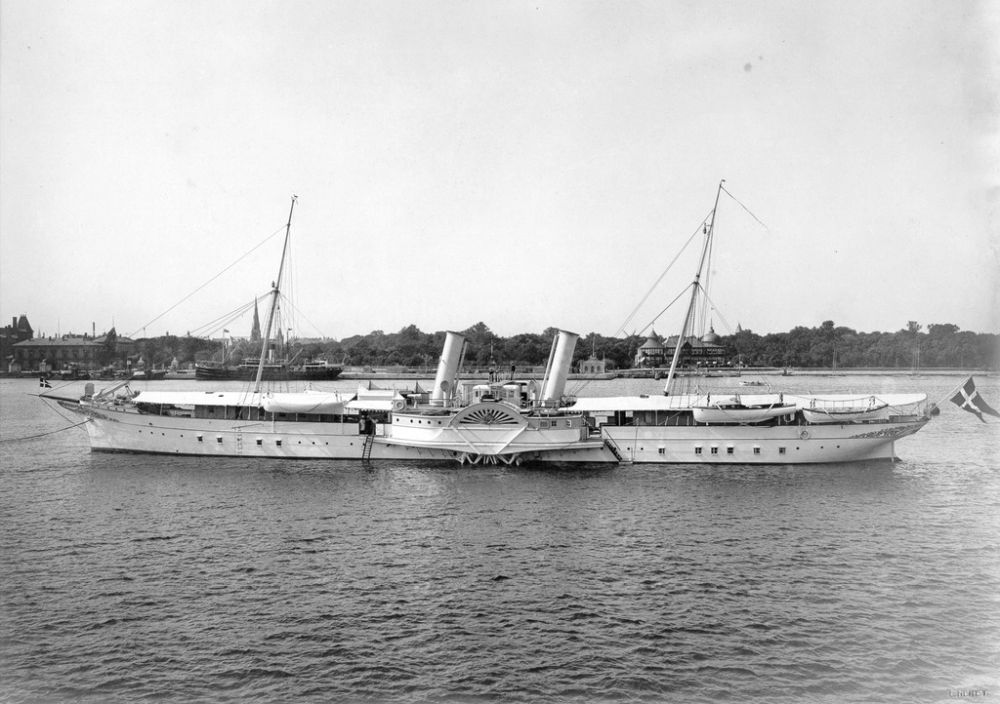
Denmark
can claim the most modern paddle steamer built in Europe for royal use
and the last such vessel to be decommissioned : Dannebrog
Photo by kind courtesy of Nationalmuseet Kobenhavn : Creative Commons licence https://creativecommons.org/licenses/by-sa/3.0/
Between 1855 and 1880, the Danish Navy paddle steamer Slesvig
was used as a Royal Yacht. Converted in 1855, the ship was built in
1846 by Robert Napier at Govan, Scotland as Copenhagen for CH Donner
& Co of Altona (now part of Hanburg, Germany). It was taken over by
the Danish Navy in 148 and renamed Slesvig. It was used by the Post
Office for its service between Korsor and Kiel from 1850 to 1854.
From 1880 until 1893 it was back in use by the navy.
Dannebrog
entered royal service in 1880. She is seen above in 1913 after a major
reconstruction in 1907 when she was lengthened, re-engined and received
a second funnel. She was replaced in 1932 by a diesel-engined screw
ship of the same name and was scrapped during 1934
GERMANY
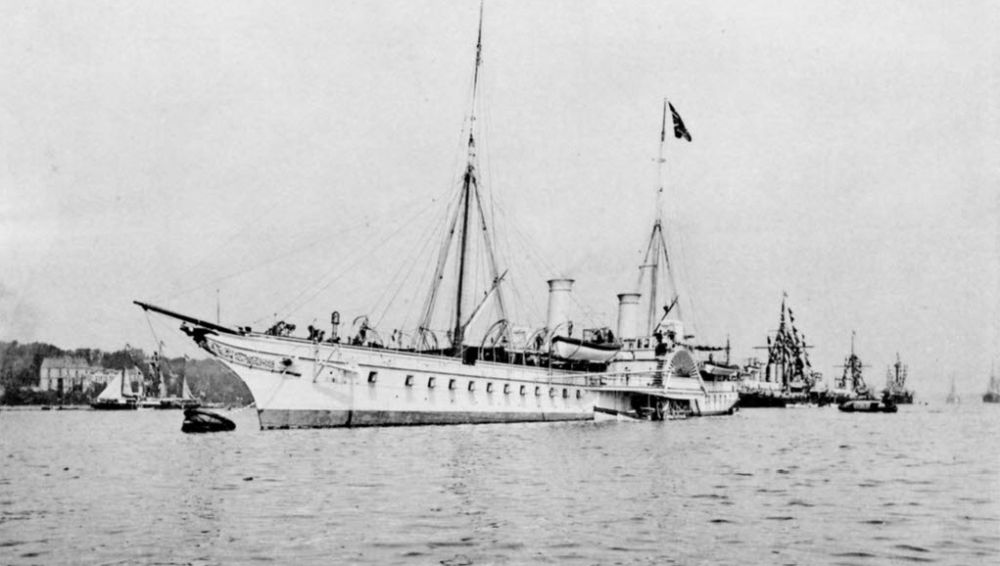
Hohenzollern (1878-1909, renamed Kaiseradler in 1892 when a second Hohenzollern, a screw steamer, entered service)
Built
in Kiel by Norddeutschen Schiffbau AG, the 82 m long paddler entered
service in 1880. Replaced as principal yacht in 1892, she still took
part in many activities, notably the opening of the Kiel canal in
1893. Removed from service in 1909. she was scrapped in Danzig
(now Gdansk)
Photo in the public domain - from the collection of Gesellschaft fur Kieler Stadtgeschichte
AUSTRIA
Greif (1869-1885)
Built
in London in 1857. 69 m, 1350 GT. Originally the Jupiter, she was
bought by the Austrian navy in 1859 and scuttled at the entrance to the
Venice lagoon.
It was raised and became an Aviso in the navy before being converted for use as an Imperial Yacht.
Carried Emperor Franz Josef to the opening of the Suez Canal in 1869. Decommissioned, hulked and renamed Alpha in 1885. Used for torpedo training
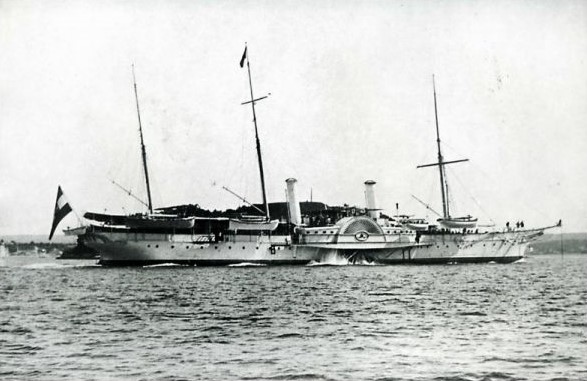
Fantasie (1858)
Built by the Thames Ironworks & Shipbuilding Co at London. 55 m, 408 GT.
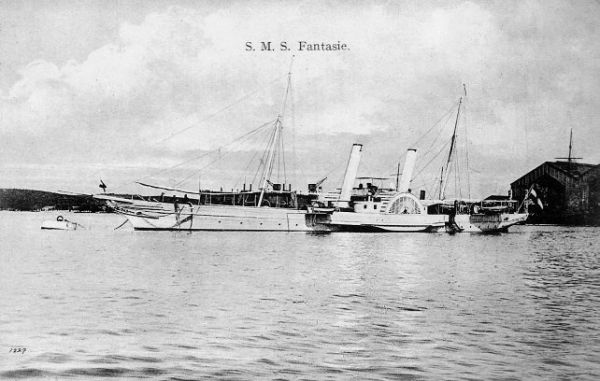
Miramar (1872)
Built by Samuda Bros, Poplar, London. 92.7 m, 1968 GT.
Extensively used by the Imperial family, especially Empress Sissi
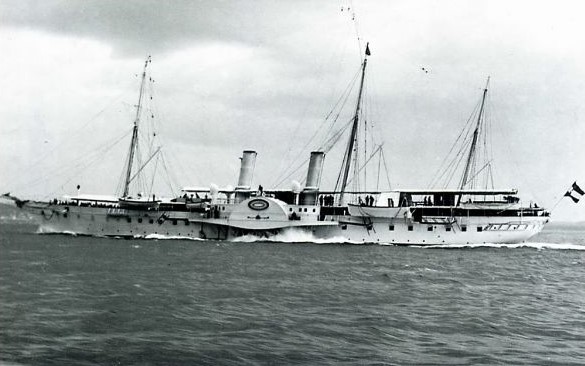
With help from the Serbian forum on Paluba
The Austrian (Austro-Hungarian from 1867) Navy had several paddle "Avisos"
Vulcano
(1843), Messagiere (1847), Achilles (1848), Custoza (1848), Curtatone
(1848), Roma (1848), Santa Lucia (1850), Volta (1850), Kaiserin
Eliasbeth (1850), Taurus (1851), Gorzkowski (1854), Prinz Eugen (1854)
and Jupiter (1857)
RUSSIA
Standart (1857-
Dzerhava (1871-1898, surviving as a training ship until 1905) Length : 94.8 m
Livadia (1873-1878, wrecked on the Crimean Coast during the Russo-Turkish war)
Tsarevna (1874-1917)
JAPAN
Jingei (1882-1886)
Jingei
was already outdated when she was commissioned having been in
construction for almost ten years. She was used very little and
was turned over for various Imperial Navy purposes, remaining in
service until 1903 and then hulked
FRANCE
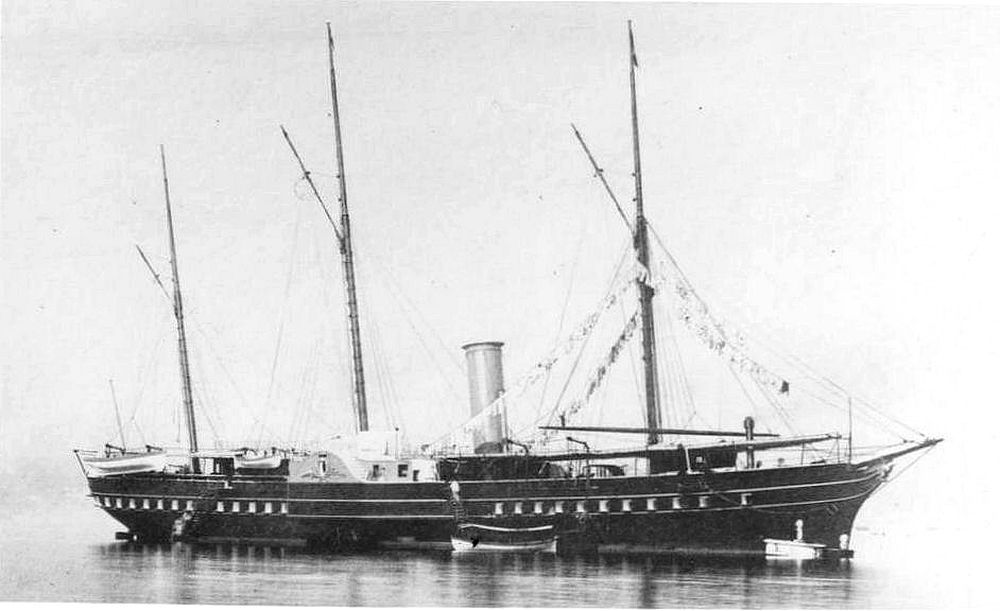
Above
: French Imperial Royal Yacht L'Aigle at Port Said in 1869 on the
occasion of the opening of the Suez Canal, attended by Empress Eugenie.
Source : wikipedia - photographer unknown
Built in Cherbourg in 1857 to replace the previous vessel "La Reine Hortense"
Overall length 90 metres (82 at the waterline)
2 x cylinders of 2000 mm - piston stroke 1800 mm
Converted to a gunboat in 1870 and from 1873 was a corvette renamed "Le Rapide"
Decommissioned in 1885 and sold in 1891. Scrapped at Cherbourg
GREECE
Amphriti
Built in 1865 by Laird at Birkenhead
240 ft : 659 GRT.
Originally built as Penguin to the order of agents for the US Confederacy but not completed in time to fulfill that role
Sold
to the Greek government as a naval vessel in 1867 with the intention of
being used to assist the uprising in Crete against Ottoman rule
Converted to a Royal Yacht in 1869 and used by King Georgios I
OTTOMAN EMPIRE (now TURKEY)
It
is unclear exactly what can be regarded as an Imperial Yacht for the
Ottoman Sultan. A number of vessels (paddle steamers in the second half
of the nineteenth century) have sometimes been described as Imperial Yachts
but were naval "Aviso" ships, ie messenger vessels which were
used by the Sultan or his ministers for diplomatic missions. Istanbul,
built in England in 1865, appears to have been used by the Imperial
family for pleasure purposes and for transport to their various
residences until at least well into the twentieth century.
Sultaniye appears to
have been gifted from the Egyptian Navy by the ruling Khedive to his
imperial overseer, the Sultan, and extensively used for diplomatic
purposes and possibly personal use until assigned to the navy full time as an Aviso
Istanbul
Appears to be very similar to the four "Avisos" built in London for the Ottoman Navy in 1865 (Talia, Izzedine, Fuad and Ismail)
Sultaniye
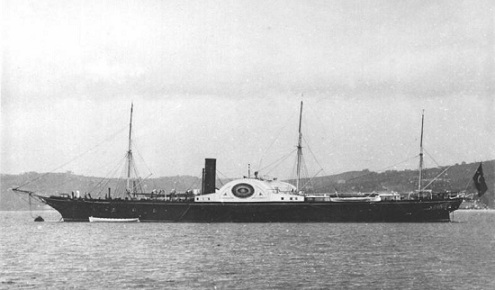
Built in 1853 by CJ Mare at Blackwall (near London)
391.1 ft. Engine by Maudsley & Co of London
Built for the navy of the Ottoman province of Egypt and named Feyz-i Cihat
Rebuilt in 1861 by Forrester & Co at Liverpool
Given to the Ottoman Sultan as a gift in 1862 and renamed Sultaniye
Used for numerous diplomatic missions
From 1877 it was used as an Aviso by the Ottoman Navy
Laid up in 1905
Scuttled at the harbour entrance of Izmir in 1912 in anticipation of an Italian attack on the port
EGYPT
(Part of the Ottoman Empire until 1914, ruled as a semi-independent
Khedivate from 1867 and under British control until independent as
Kingdom from 1922)
1849 : Sayed Pacha : Built by Caird of Greenock for Mohammed Said
1865 : El Mahrousa (converted to turbine steamer in 1905 and still in existence) and Bordein, both by Samuda Bros, London, for Khedive Ismail Pacha
1926 : Kased Kheir : Built by JI Thornycroft in Southampton in kit form for King Fuad I. 237 ft 9 in x 32 ft
EL MAHROUSA
The yacht El Mahroussa
survives in magnificent condition at Alexandria where she serves as
Egypt's presidential yacht and makes occasional short sailings. She was
originally built in 1865 by Samuda Brothers at Wapping, London, as
a paddle steamer for the Khedive Ismail Pasha, with two cylinder
oscillating engines built by J Penn (2 x 110 in x 96 in). The vessel,
which
remained in royal service until 1952, is much changed from the ship
originally delivered. Lengthened by 40 ft in an Italian yard in 1872
then again by 16 ft at Inglis' yard in Glasgow in 1905, she was also
converted to screw propulsion and fitted with Parsons steam turbines
built at their own engine works. In 1905, turbines were still a new
form of marine engineering, the first commercial ship to be so equipped
being only four years previously. In 1919 she was converted from
burning coal to burning diesel oil. She has had an interesting history,
being the first vessel to sail through the Suez Canal when officially
opened in 1869, escorted royalty into exile, including ex-King Farouk
in 1952 (at the time the ship was renamed as El Horriya)
and even went to the United States for that country's bi-centennial
celebrations in New York in 1976. She returned to her original name in
2000. In 2015 she was the ship used to inaugurate the New Suez Canal
built alongside the original canal to increase capacity
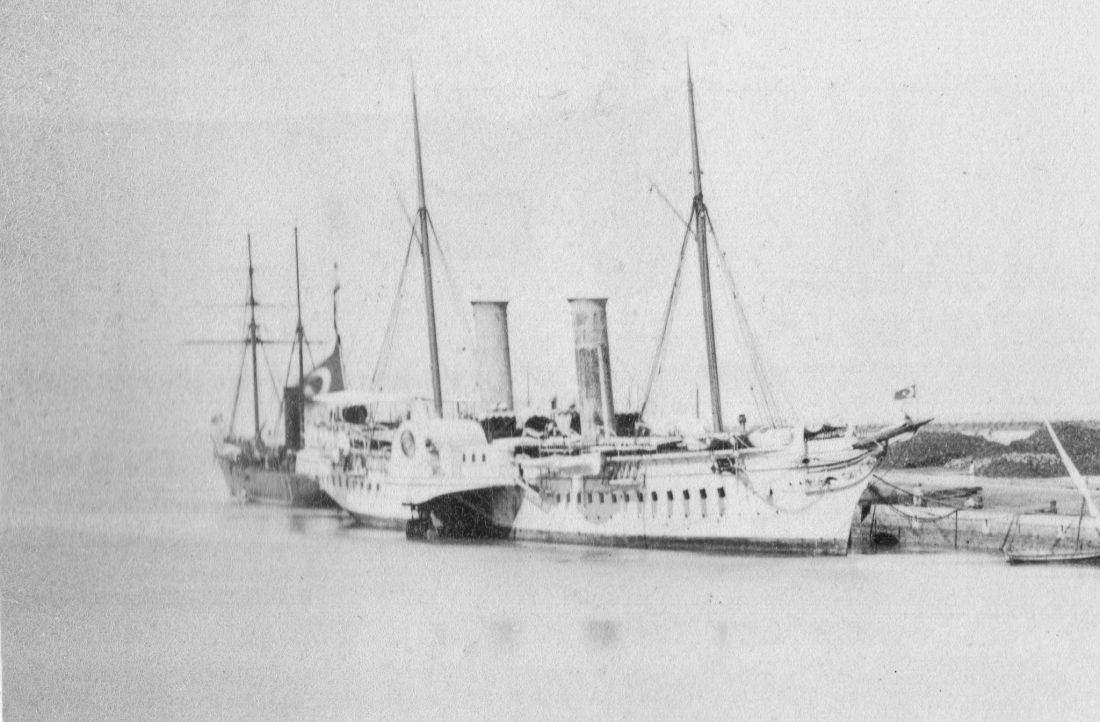
Above
: This is thought to be a photo of El Mahrousa in her days as a paddle
steamer. Photo by kind courtesy of Istvan Radi from his collection
KASSED KHEIR
Kased
Kheir was used to take the deposed King Farouk into exile in 1952. In
1958 it was used as an annexe at the Navy Hotel in Cairo. Reportedly
sand in 1971 near Edfu, upper Nile after catching fire on a cruise.
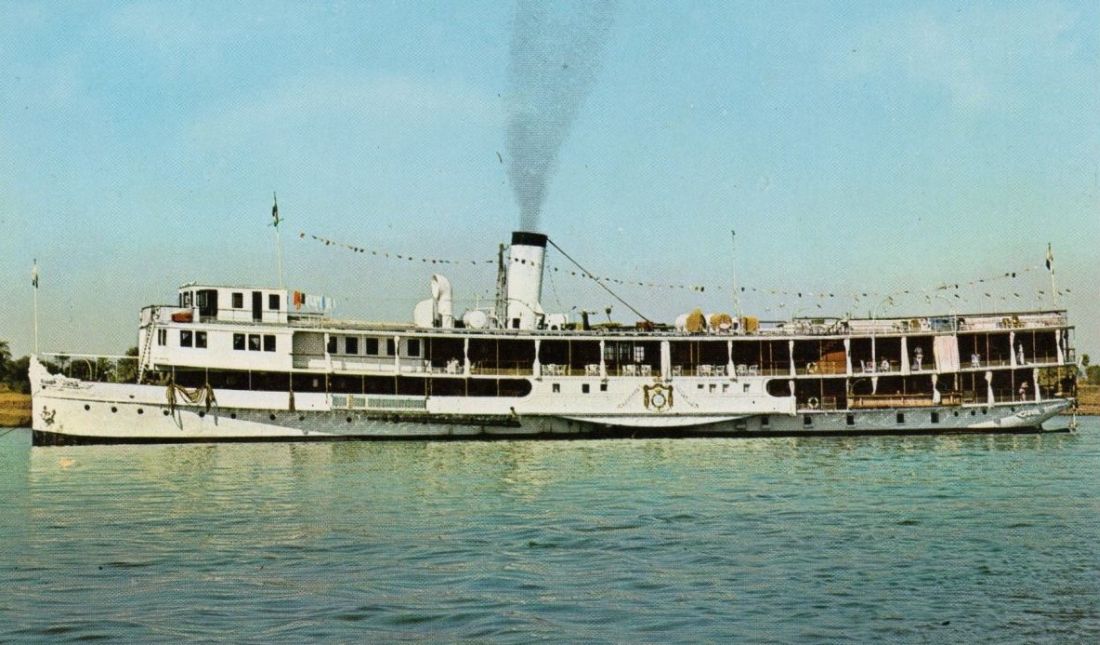
Above : Post card view by kind courtesy of Norman Stewart
Quarter-Wheel Steamer Karim
A steam-fired paddler, built in 1917. She is understood to have been built to
a design of the Lytham Shipbuilding & Engineering Co for use
on the Rivers Tigris and Eurphrates in Baghdad for the British Army.
A number of vessels were sent to Iraq, but possibly six (one of
which which became Karim), went for use in Egypt instead. Soon afterwards
she was used by the then Sultan, later King Fuad
I of Egypt and later by his son and, after the republican revolution, state presidents.
She has been in regular passenger service for public cruises
since refurbishment in 1991. The 45.8
metre long vessel has 15 luxury cabins and is equipped for 30
passengers. Her normal schedule is for 7-night cruises from Luxor to
the Aswan Dam at Lake Nasser and is operated by local company Spring Tours.
She has stern-placed side wheels, the so-called "quarter-wheel"
arrangement, which can be operated independently and are driven
by two compound engines.
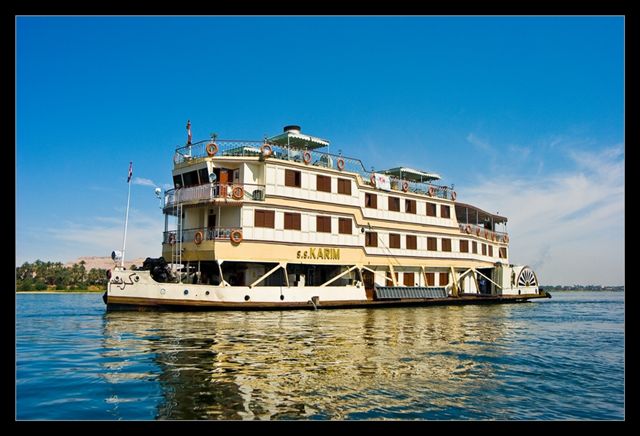
Photo kindly supplied by Mr Morsi Shehata, General
Manager of Spring Tours
A
number of vessels were recorded as having been built for the Khedive of
Egypt. Whether these were Royal Yachts in the true sense of the word is
unclear
Nile : Built in 1862 by Jones, Quiggin at Liverpool. 1350 GT
The
Eyptian government also owned a number of paddle steamers in the second
half of the nineteenth century which the ruling Khedive no doubt used
on occasion
Fayoum : Built in 1864 by Samuda Bros. at Poplar, London. 289 ft : 1642 GT. Converted to a screw steamer in 1881
ROMANIA
It is believed that the Danube river paddle steamer Borcea,
built in 1914, was for the use of King Ferdinand of Romania until
seized in the wake of World War II. After a long and varied career, she
remains in use at Braila, Romania
Return
to
Historical
Database











